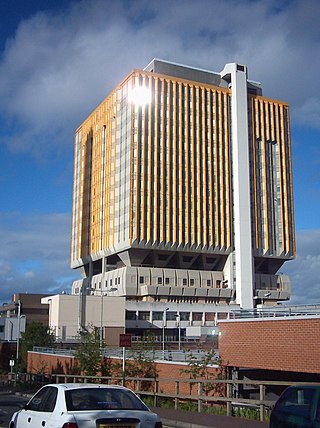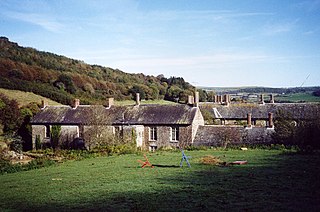Related Research Articles

In Britain, a workhouse was an institution where those unable to support themselves financially were offered accommodation and employment. The earliest known use of the term workhouse is from 1631, in an account by the mayor of Abingdon reporting that "we have erected wthn [sic] our borough a workhouse to set poorer people to work".

St James's University Hospital is in Leeds, West Yorkshire, England and is popularly known as Jimmy's. It is one of the United Kingdom's most famous hospitals due to its coverage on television. It is managed by the Leeds Teaching Hospitals NHS Trust.

Southmead Hospital is a large public National Health Service hospital, situated in the area of Southmead, though in Horfield ward, in the northern suburbs of Bristol, England. It is part of the North Bristol NHS Trust. The 800-bed Brunel Building opened in May 2014, to provide services, which transferred from Frenchay Hospital in advance of its closure. The hospital site covers 60 acres (24 ha).

Selly Oak Hospital was situated in the Selly Oak area of Birmingham, England. Previously managed by the University Hospitals Birmingham NHS Foundation Trust, the hospital closed in 2011.

The Andover workhouse scandal of the mid-1840s exposed serious defects in the administration of the English 'New Poor Law'. It led to significant changes in its central supervision and to increased parliamentary scrutiny. The scandal began with the revelation in August 1845 that inmates of the workhouse in Andover, Hampshire, England were driven by hunger to eat the marrow and gristle from bones which they were to crush to make fertilizer. The inmates' rations set by the local Poor Law guardians were less than the subsistence diet decreed by the central Poor Law Commission (PLC), and the master of the workhouse was diverting some of the funds, or the rations, for private gain. The guardians were loath to lose the services of the master, despite this and despite allegations of the master's drunkenness on duty and sexual abuse of female inmates. The commission eventually exercised its power to order dismissal of the master, after ordering two enquiries by an assistant-commissioner subject to a conflict of interest; the conduct of the second, more public inquiry drew criticism.

The Belfast City Hospital in Belfast, Northern Ireland, is a 900-bed modern university teaching hospital providing local acute services and key regional specialities. Its distinctive orange tower block dominates the Belfast skyline being the third tallest storeyed building in Ireland. It has a focus on the development of regional cancer and renal services. It is managed by Belfast Health and Social Care Trust and is the largest general hospital in the United Kingdom. In April 2020, due to the global coronavirus pandemic, the tower block was designated one of the UK's Nightingale Hospitals.
The Metropolitan Asylums Board (MAB) was established under Poor Law legislation to deal with London's sick and poor. It was established by the Metropolitan Poor Act 1867 and dissolved in 1930, when its functions were transferred to the London County Council.

Bassetlaw District General Hospital is a National Health Service hospital in Worksop, Nottinghamshire. It is managed by the Doncaster and Bassetlaw Teaching Hospitals NHS Foundation Trust.

University Hospital Lewisham is a teaching hospital run by Lewisham and Greenwich NHS Trust and serving the London Borough of Lewisham. It is now affiliated with King's College London and forms part of the King's Health Partners academic health science centre. It is situated on Lewisham High Street between Lewisham and Catford.

The Poor Law (Scotland) Act 1845 was an Act of Parliament that reformed the Poor Law system of Scotland.

Louisa Twining was an English philanthropic worker who devoted herself to issues and tasks related to the English Poor Law. Her family owned the famous Twinings tea business on the Strand, which is a renowned business nowadays. In the early part of her adult life, Louisa was an artist and art historian. In her 30s she started work on projects related to the Poor Law which she followed for the rest of her life. She helped to establish a home for workhouse girls and a number of societies and associations related to workhouses and infirmaries. She also served as a Poor Law guardian and was president of the Women's Local Government Society.

The Cleveland Street Workhouse is a Georgian property in Cleveland Street, Marylebone, built between 1775 and 1778 for the care of the sick and poor of the parish of St Paul Covent Garden under the Old Poor Law. From 1836, it became the workhouse of the Strand Union of parishes. The building remained in operation until 2005 after witnessing the complex evolution of the healthcare system in England. After functioning as a workhouse, the building became a workhouse infirmary before being acquired by the Middlesex Hospital and finally falling under the NHS. In the last century it was known as the Middlesex Hospital Annexe and the Outpatient Department. It closed to the public in 2005 and it has since been vacated. On 14 March 2011 the entire building became Grade II Listed. Development of the site began in 2019 by current owner University College London Hospitals (UCLH) Charity as a mixed-use development including residential, commercial and open space, but construction has been held up by the necessity to remove human remains stemming from the use of the area around the workhouse as a parish burial ground between 1780 and 1853. There has also been controversy about the amount of social housing to be included in the development.

Southlands Hospital is a medical facility based in Shoreham-by-Sea, West Sussex, England, which serves people living in Shoreham itself as well as Worthing and other towns and villages along the south coast and in the inland areas of West Sussex. It is managed by the University Hospitals Sussex NHS Foundation Trust.

Joseph Rogers (1821–1889) was an English physician and campaigning medical officer.

St Alfege's Hospital was a hospital that operated in the Maze Hill area of east Greenwich in southeast London. It operated as the Greenwich Union Infirmary from 1874 to 1929. It was briefly known as the Greenwich and Deptford Hospital before becoming St Alfege's Hospital in 1931. It was then superseded by Greenwich District Hospital in 1968.

Albro Castle is a former workhouse in the north of the village of St Dogmaels, Pembrokeshire, Wales. The building was Grade II* listed in 1992 as one of the least-altered workhouses in Wales. After closing as a workhouse in 1935 the buildings were bought by Pembrokeshire County Council and in 1948 were sold into private ownership.

Brownlow Hill infirmary was a large workhouse infirmary in Liverpool, notable for its role in advancing training of nurses. The workhouse was demolished in 1931, and the site is now occupied by Liverpool's Catholic cathedral.
The Association for the Improvement of the Infirmaries of London Workhouses was established on 3 March 1866 at a public meeting organised by Joseph Rogers, and Drs. Hart, Anstie and Carr of the Lancet. It was chaired by Henry Herbert, 4th Earl of Carnarvon. Charles Dickens and John Stuart Mill were present. It campaigned for the provision of six Poor Law hospitals in London of one thousand beds each, with trained nurses, resident medical officers, and medicines financed from the rates. Carnarvon denounced the dreadful and disgraceful conditions in workhouse infirmaries and the guardians responsible for them. He helped to pass the Poor Law Amendment Act 1867.
Workhouse infirmaries were established in the nineteenth century in England. They developed from the Workhouse and were run under the Poor law regime.
References
- ↑ "Content: Folios 334-335. Letter from Uvedale Corbett junior, District Auditor,..." National Archives. National Archives. Retrieved 11 June 2017.
- ↑ Ayers, Gwendoline (1971). England’s First State Hospitals. Wellcome Institute of the History of Medicine. p. 12. Retrieved 11 June 2017.
- ↑ Rivett, Geoffrey. "The Poor Law Infirmaries". NHS History. Retrieved 11 June 2017.
- ↑ "Poor Law Conference at Shrewsbury". Welsh Newspapers Online: The Cambrian News and Merionethshire Standard. 29 October 1875. Retrieved 11 June 2017.